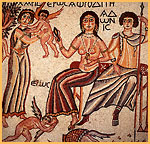|
Pagan culture and Christianity
The traditional polytheist religion of the Roman
empire was gradually  suppressed,
as Christian emperors prohibited the performance of pagan
cults (392), ordered the destruction of pagan temples (435),
or banned pagans from high offices and the teaching profession
(529). Zealous government officials, bishops and monks instigated
the persecution of pagan intellectuals, the sacking of temples,
and the destruction of numerous treasures of ancient art.
Religious intolerance, however, did not prevent pagan culture
from enduring. The litterature and learning of classical antiquity
remained the basis of education in the Early Byzantine period
(and later), and cities such as Athens, Berytus (Beyrouth),
and Alexandria flourished as intellectual centres until the
sixth century. A taste for the classical persevered among
the rich and the well educated who favored pagan imagery for
the decoration of their interiors and personnal objects. Pagan
deities (Dionysos, Aphrodite, Apollo) and antique personnifications
frequently appear on suppressed,
as Christian emperors prohibited the performance of pagan
cults (392), ordered the destruction of pagan temples (435),
or banned pagans from high offices and the teaching profession
(529). Zealous government officials, bishops and monks instigated
the persecution of pagan intellectuals, the sacking of temples,
and the destruction of numerous treasures of ancient art.
Religious intolerance, however, did not prevent pagan culture
from enduring. The litterature and learning of classical antiquity
remained the basis of education in the Early Byzantine period
(and later), and cities such as Athens, Berytus (Beyrouth),
and Alexandria flourished as intellectual centres until the
sixth century. A taste for the classical persevered among
the rich and the well educated who favored pagan imagery for
the decoration of their interiors and personnal objects. Pagan
deities (Dionysos, Aphrodite, Apollo) and antique personnifications
frequently appear on  mosaics,
manuscripts, ivory diptychs and other objects. Even biblical
manuscripts, such as the Vienna Genesis, make use of pagan
personnae such as Nymphs. mosaics,
manuscripts, ivory diptychs and other objects. Even biblical
manuscripts, such as the Vienna Genesis, make use of pagan
personnae such as Nymphs.
At the same time, pagan iconography was adapted to
Christian purposes. The iconographical types of biblical personnae
often derive from classical antiquity: images of Christ surrounded
by his disciples draw upon representations of pagan philosophers
and their pupils; antique bucolic imagery inspired the representation
of Christ as the Good Shepherd. The angels on the Barberini
ivory panel reproduce the attitude and costume of the winged
wreath-bearing Nike (Victory), depicted on the same
object. Moreover, imperial iconography, deaply rooted as it
was in Roman tradition, was given a Christian significance:
the pagan themes of tribute to majesty, victory, and prosperity,
surrounding the earthly ruler, are blessed by the figure of
Christ. Likewise, Early Christian sarcophagi combine pagan
figural tradition with newly introduced subjects from the
Old and New Testaments. Biblical episodes, many of which are
related to the Christian concept of resurrection, replace
the mythological and genre scenes of pagan sarcophagi.
|